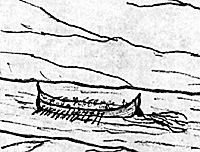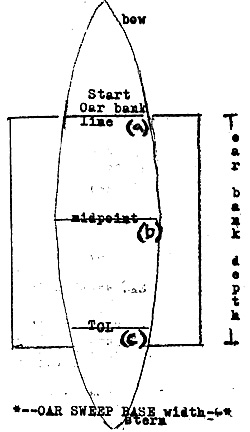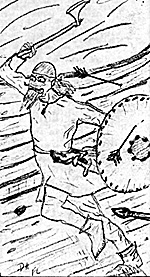 As a part of the campaign wargaming I've been involved in
over the last few years, I have developed am interest is
recreating encounters between armies on water. I hesitate to use
tke term "Medieval battle" in the Dark Ages. Dark Ages sea battles
didn't rely on the complex patterns and movements that the early
Greeks or Romans employed. Ramming was for the most part little used or
of less effect in Scandanavian or English/Eurepoan encounters.
Rammin,g when done, was used more to temporarily disorder the
enemy crew as prelude to boarding--as opposod to the Greek and
Roma objective of keeling/sinking the enemy vessels.
As a part of the campaign wargaming I've been involved in
over the last few years, I have developed am interest is
recreating encounters between armies on water. I hesitate to use
tke term "Medieval battle" in the Dark Ages. Dark Ages sea battles
didn't rely on the complex patterns and movements that the early
Greeks or Romans employed. Ramming was for the most part little used or
of less effect in Scandanavian or English/Eurepoan encounters.
Rammin,g when done, was used more to temporarily disorder the
enemy crew as prelude to boarding--as opposod to the Greek and
Roma objective of keeling/sinking the enemy vessels.
With these basic differences I have set out to create a set of guidelines by which wargamers may enjoy either campaign or set- piece battles with their existing figure basing. Anyone who possesses Vikings Saxon, Welch, Norman or a host of other Western infantry figures can fight fairly large battles with a minimum of additional work to create a fleet. A minimum number of single based figures is also an objective of those rules, I've been amused in the past when I've seen rules for the sea suggest single figure basing. That's just what I always wasted to do... take my tabletop 25mm Vikings and glue them all on individual bases for a sea battle and then rebase them all back for my next tabletop encounter 45 mintes later in the campaign...or move 1250 points of infantry around on single bases!
Be that as it may I shall begin to outline a method for sea encounters of the Scandinavian, English, and European, Dark Ages type. I still have considerable research to do before I attempt to address the methods of Eastern armies.
![]() For the moment I will be considering seven basic types of
vessel and all are basically Norse in design. This is because if
someone was building a ship in those days, he was either a viking
or most likely descended from Vikings. Next time you see a
library, look up the Bayeux tapestry. This tapestry was made by
Normans and depicts Norman vessels. However they look very Viking. This
was the Western shipbuilding of the Dark Ages.
For the moment I will be considering seven basic types of
vessel and all are basically Norse in design. This is because if
someone was building a ship in those days, he was either a viking
or most likely descended from Vikings. Next time you see a
library, look up the Bayeux tapestry. This tapestry was made by
Normans and depicts Norman vessels. However they look very Viking. This
was the Western shipbuilding of the Dark Ages.
Clinker-built and double prowed, the Norse style vessels proved light and fast, drawing very little to provide easy access to shallow waters. Of the seven types of vessals, we will initially use, we can further divide these into three classes.
The first in the Longship or Dragonship. These are the fast sleek canoe-like Viking warships. Length to width ratio was from 4 to 1 to a rare maximum of 7 to 1. These vessels were common is the coastal waters of Scandinavia but less common on long raids, Muck more common in English or European waters was the Karfi or Raider class. Tkese vessals, although shorter and wider in general, were much more seaworthy and reliable than the true Loagship. The last class is the short, almost round Kaupskip cargo vessel used mainly for transport.
These three classes of vessel are by so Reams an exhastive study of Western shipbuilding In the Dark Ages. However the use of just seven types depicts the differing sizes of vessel very realistically without a maze of complications.
Before we outline the pre-game set-up each player must first equip him/herself with the appropriate number of SHIP BASES to represent his vessals. In future issues I will outline methods that can be used to create-very realistic ship models conforming to the SHIP BASE method. For now it is best to use simple cardboard SHIP BASES like the one I've enclosed with this Issue. Each type of vessel has a maximum size (length/width) listed below along with its crew sizes for three levels of efficiency and a HULL FACTOR.
HULL FACTOR
Each of the seven types of vessel have been assigned a number (l.2.3. or 4). The higher the number the stronger and higher the vessel. A 4 rated hull will have both a strength and height advantage over a 1, 2, or 3 rated hull.
SEVEN BASIC VESSALS FOR WARGAMING (25mm)
A) The Dragonships and Longships (4 types)
 1) The Kings Dragonship: one per fleet (ship value 240 pts.)
1) The Kings Dragonship: one per fleet (ship value 240 pts.)
- a. HULL FACTOR- 4
b. Minimum Crew- 10 to 13 figures
c. Normal Crew- 14 to 19 fig.
d. Battle Crew- 20 to 32 fig.
e. Rare vessel, only Kings of great power would possess a vessel of this size: 120 to 150 fact long.
 2) Dragonship: one for each five in fleet (ship value 200 pts)
2) Dragonship: one for each five in fleet (ship value 200 pts)
- a. HULL FACTOR- 3
b. Minimum Crew- 8 to 11 fig*
c. Normal Crew- 12 to 17 fig.
d. Battle Crew- 18 to 28 fig.
e. A powerful Jarl or lesser King might own a vessel such as this: 90 to 120 feet long. About 35 banks of oars
 3) Snekja (or large) Longship- up to 100% of float in Scandinavian
or Danish waters. Up to 40% of fleet in other waters. (value 125 Pts.)
3) Snekja (or large) Longship- up to 100% of float in Scandinavian
or Danish waters. Up to 40% of fleet in other waters. (value 125 Pts.)
- a. HULL FACTOR- 2
b. Minimum Crew- 6 to 9 figs
c. Normal Crew- 10 to 15 fig.
d. Battle Crew- 16 to 22 figs.
e. This is a common type of vessel that jarls and men of influence and wealth might command: 70 to 90 foot long. A twenty bencher (40 oars).
 4) Skuta Longship: up to 100% of fleet in Scandinavian
Waters, Up to 40% of fleet is other waters. (value 85 pts.)
4) Skuta Longship: up to 100% of fleet in Scandinavian
Waters, Up to 40% of fleet is other waters. (value 85 pts.)
- a. HULL FACTOR- 1
b. Minimum Crew- 3 to 5 fig,
c. Normal Crew- 6 to 9 fig.
d. Battle Crew- 10 to 15 fig,
e. This is a small Longship and may be commanded by a huscarl and crewed by mostly unaraoured none 50 to 70 feet long with as few as 20 oars.
B) The Karfi Raiders ( 2 types )
 5) Karfi Raider: up to 100% of any fleet (value 90 pts.)
5) Karfi Raider: up to 100% of any fleet (value 90 pts.)
- a. HULL FACTOR- 3
b. Minimum Crew- 4 to 7 figs
c. Normal Crew- 8 to 12 fig.
d. Battle Crew- 13 to 24 figs
e. Manned similar to the large Longship (Snekja) the Karfis are wider, slower and less manuverable but far more seaworthy than longships. These vessels were the common and predominant raiding vessels: 70 to 90 feet long, a twenty bencher.
 6) Small Karfi Raider: up to 100% of any fleet (value 60 pts.)
6) Small Karfi Raider: up to 100% of any fleet (value 60 pts.)
- a. HULL FACTOR- 2
b. Mininum Crew- 2 to 4 figs
c. Normal Crew- 5 to 9 figs
d. Battle Crew- 10 to 16 figs
e. Similar to the Skuta longship in crew. 50 to 70 feet long.
C) Transport vessels (1 type)
 7) Kaupship Cargo Ship (value 60 pts.)
7) Kaupship Cargo Ship (value 60 pts.)
- a. Hull Factor: 2
b. Mixiaux Crew- 1 fig
c. Normal crew- 2 to 4 figs
d. Battle Crew- 5 to 25 figs
e. Short almost round type of vessel the Kaupship almost never moved with oars just waiting if there was no wind for sails. Very seaworthy but very poor speed and mauverability.
To make your SHIP BASES make a pattern first with paper. Out a rectangle to the length and width desired and then fold in half and then into quarters. Cut one curved side to unfold in the shape of a ship. Use this pattern to cut your first SHIP out of cardboard and use this first ship as a template for others of that size and shape.
Crews
- MINIMUM CREW- This is the number of figures that are needed
to initiate any kind of movenext or action, usually with severe
restrictions. Vessels that fall below minimum crew are unable to
move and will suffer morale penalties.
NORMAL CREW- To attain normal speed and manuverability, a vessel will have to have at least this number of crew.
BATTLE CREW- With this crew level, a vessel has maximum efficiency in all areas of melee and maneuvering, along with reserve strength.
After your SHIP-BASES are prepared you need to make an OAR SWEEP BASE for each vessel. This is a simple matter of cutting a rectangle of light paper to the proscribed size for each vessel and placing it under the SHIP BASE whenever oars are in use. When moving the vessel, place the tips of your thumb and second finger one ach side of your vessel so your fingertips contact both the SHIP BASE and OAR SWEEP BASE. Both will move together easily and the area that is needed for each ship type's oars will be clearly marked.
 D) OAR SWEEP BASE dimensions
D) OAR SWEEP BASE dimensions
1) King's Dragon
- a. oars siart 4" from bow.
b. Oar banks run 10.5" deep.
c. OAR SWEEP BASE 5" wide
2) Dragon Ship
- a. Oars start 3.5" from bow
b. Oar banks rux 8.5" deep
c. OAR SWEEP BASE 5" wide*
3) Snekja Large Longship
- a. Oars start 3" from bow
b. Oar banks run 5" deep
c. OAR SWEEP.BASE 4.5" wide
4) Skuta Longship
- a. Oars start 2" from bow
b. Oar banks run 3.5" deep
c. OAR SWEEP BASE 4" wide
5)Large Karfi Raider
- a. Oars start 3.5 " from bow
b. Oar banks run 5" deep
c. OAR SWEEP BASE 5" wide
6) Small Karfi Raider
- a.Oars start 3" from bewo
b. Oar banks run 4" teepe
c. OAR SWEEP BASE 5" wide
7) Kaupship Cargo Vessel
- a. Oars start 6" from bow
b. Oar banks run 1.5" deep
c. OAR SWEEP BASE 7" wide
Once the SHIP BASE and OAR SWEEP BASE are complete, three points of importance must be marked on the SHIP BASE. A line should be drawn across the SHIP BASE to mark:
- a. the point where the Oar Banks begin
b. the mid-point of the vessel
c. This point has a separate place on each vessel type. During movement, all miniatures involved in movement must be placed nehind this line. All figures eligible to use DISTANCE WEAPONS or preparing to engage in a BATTLE CONTACT this period must be placed forward of this line. This line is known as the TRANSPORT CREW LINE.
3) TRANSPORT CREW LINE placement. (Ships correspond to above numbers)
- 1) 8" from stern
2) 7" from stern
3) 6" from stern
4) 4" from stern
5) 5" from stern
6) 4" from stern
7) 2" from stern
At this point we have our vessel capacity and dimensions established. The next step is game set up.
 GAME SET-UP
GAME SET-UP
MATERIALS NEEDED other than SHIP BASES and figures:
- 1. inch ruler
2. 1d10 dice (or use two 1-6 dice subtracting two and rolling over for snake eyes)
3. Protractor
TABLE SIZE should be at least 4X8 feet. If table is less tjan 5 feet wide then start your fleets from both ends instead of the sides.
TERRAIN SET-UP The first stop is to determine if your battle is taking place on a river, coastal area or the open seas. If your battle is part of a campaign then use the appropriate category. If your battle is a set-piece encounter, then attempt mutual agreement first. If that fails then both players roll one die and high die chooses one terrain category.
RIVER SET-UP:
Players enter board from opposite axis. Both sides are considered to be shoreline or impassable shallows. Both players may set out up to 4 areas of shallows or sandbars up to 12" by 12".
Sandbar impassable to all vessals. Shallows impassable to Kerfis or Kaupships: Roll 1-10 dice for each feature: odds remove, evens stay.
COAST SET-UP:
Players enter board from opposite ends. Long sides should be declared coastline. Each player may place up to 5 12" by 12" areas representing sandbar, shallows, or rocks of all terrain, areas must touch the coastline side. Roll 1-10 for each feature: odd remove, even stay.
OPEN SEA, SET-UP:
Players enter from sides if table at least five foot wide, otherwise enter from ends. Each player may place one terrain feature that automatically stays.
WIND DIRECTION
Is tke aoxt stop In gas* not-upo Pirst designate site table edge as NORTH. Roll one d10.
Wind blows from
- 1 North
2 Northeast
3 East
Soutkeast
South
6 Southwest
7 West
8 Northwest
9-10) Roll-again
WIND SPEED must now be diced foro Roll 1d10
- 1-6: winds light
7-8: winds moderate
9: heavy Wlads
10: no wind
DRIFT DIRECTION
Is now diced for: use same as WIND DIRECTION. DRIFT SPEED is now diced for:
- 1-3: 1" drift per turn
4-6: 2" drift per turn,
7-9: 0" drift per turn
0: 3" drift per tura.
DEPLOYMENT of the fleets is now done. Each player rolls d10. The loser places his largest ship on his end of tke table with its stern touching the edge. This is now his limit of deployment (length of his longest ship deep, full table edge wide).
Now the other player places his longest ship on board to define the limits of his deployment areas. Both players alternate placing vessals one by one. If one or both players wish to lash ships together, this must be announced as the vessal is placed on the table. Vessels may not be lashed together after the DEPLOYMENT PERIOD. If a player has lasked ALL vessals together, it must be moved from one foot away from baseline to one foot away from centerline after deployment and before the first movement period.
At this point, game set up is complete.
In the next issue of SAGA I will outline the mechanics of movement and game play. I intended these rules to adapt to WRG, but after the outpouring of hate mail, I have reworked my concepts.
Back to Saga # 2 Table of Contents
Back to Saga List of Issues
Back to MagWeb Master Magazine List
© Copyright 1986 by Terry Gore
This article appears in MagWeb (Magazine Web) on the Internet World Wide Web. Other military history articles and gaming articles are available at http://www.magweb.com